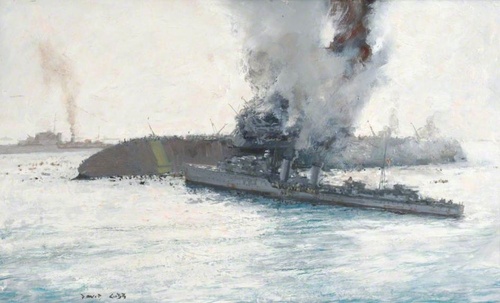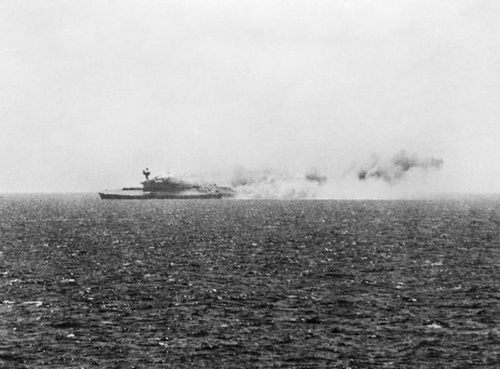Auction: 22003 - Orders, Decorations and Medals
Lot: 412
'I never did hear the order to abandon ship, but when I saw marines jumping from the flight deck, hurtling past the gundeck, and hitting the rising torpedo blister, as the ship keeled over, I really did begin to get worried. Less than two minutes had past, and the marines that had smashed themselves to jelly when they jumped had already slithered away leaving behind a blood-streaked trail of slime.
I clambered through the rails, and suddenly I too was sitting on the torpedo blister. Two ratings were already there, terrified, as they could not swim. An officer slid between the two ratings and shouted, "Now is your time to learn," and with a rating beneath each arm he dived into the sea. I never saw them again … '
George Amyes, a member of the Fleet Air Arm, recalls the tragic events that followed a multiple torpedo strike on the aircraft carrier H.M.S. Eagle, when she went down inside four minutes.
A pre-war Palestine and long service pair awarded to Chief Petty Officer (A.) F. C. Glanville, Royal Navy, who survived the loss of the aircraft carrier H.M.S. Eagle during Operation "Pedestal" in August 1942
Naval General Service 1915-62, 1 clasp, Palestine 1936-39 (P/JX. 131121 F. C. Glanville, A.B., R.N.); Royal Navy L.S. & G.C., G.VI.R., 1st issue (JX. 131121 F. C. Glanville, P.O., H.M.S. Ceylon), the last with minor official correction to surname, good very fine or better (2)
Frederick Charles Glanville was born in Portsmouth on 30 July 1912 and entered the Royal Navy as a Boy 2nd Class in November 1927, direct from Greenwich School.
Having seen active service off Palestine in H.M.S. Antelope, he joined the aircraft carrier Eagle in the summer of 1939 and remained likewise employed up until her loss in Operation "Pedestal" on 12 August 1942. Prior to that memorable convoy, Eagle had assisted in the delivery of numerous fighter aircraft to the besieged island, in addition to coming under fire at the battle of Calabria in July 1940.
"Pedestal" - loss of the "Eagle"
Eagle was assigned to the protection of "Pedestal" with her fellow carriers Victorious and Indomitable. She carried 16 Sea Hurricanes of 801 and 813 Squadrons as well as four reserve aircraft for the operation. On the early afternoon of 11 August, Eagle was hit by four torpedoes from the German submarine U-73, commanded by Helmut Rosenbaum, and sank within four minutes, 70 miles south of Cape Salinas. Losses in the sinking comprised 131 officers and ratings. Four Sea Hurricanes from 801 were aloft when the ship was torpedoed, and they landed on other carriers; the remaining sixteen went down with the ship.
George Amyes was serving with the Fleet Air Arm in Eagle at the time of her loss:
'I was standing in the shade of No.1 starboard 6-inch gun, fifty feet above the waterline. The Eagle shuddered with four distinct lurches. For some reason I thought we had hit a school of whales! The deck tilted under my feet and to my astonishment I saw a pair of seaboots flying through the air and disappear overboard. These were followed by other pieces of debris and as the ship began to list I realised that we were in serious trouble.
Loose fittings began to clatter around. Frightened voices shouted and men began to stream up from the lower decks to reach higher positions. Bodies were already floundering in the water below. And the wake of the Eagle had developed a distinct curve as the vessel pulled out of line. The rhythmic throb of the main engines died away and the ship slewed further around rapidly keeling over.
Looking over the side I was amazed to see that the green slimed bulge of the torpedo blister was above the surface of the water (Designed to withstand a charge of 750 per square inch, the torpedo blister was supposed to deflect the force of underwater explosions and preserve the hull of the ship).
I never did hear the order to abandon ship, but when I saw marines jumping from the flight deck, hurtling past the gundeck, and hitting the rising torpedo blister, as the ship keeled over, I really did begin to get worried. Less than two minutes had past, and the marines that had smashed themselves to jelly when they jumped had already slithered away leaving behind a blood-streaked trail of slime.
I clambered through the rails, and suddenly I too was sitting on the torpedo blister. Two ratings were already there, terrified, they could not swim. An officer slid between the two ratings and shouted, "Now is your time to learn," and with a rating beneath each arm he dived into the sea. I never saw them again.
Taking a deep breath I blew up my inflatable lifebelt which was a permanent part of our dress when we were afloat. Remembering our survival lectures, I hurriedly kicked off my deck shoes, pushed myself away and before I could think I was upside down 20 feet under the water and frantically holding my breath whist I looked around for a lighter colour in my surroundings that would indicate the surface. The next few seconds seemed like a lifetime and as I broke through to the surface my throat and chest seemed to explode with relief.
When I was able to think, I heard someone shouting, "Get the charges". "Oh my God!" I thought. The depth charges for the aircraft, were they primed? My horizon from wave level was limited. Eagle was just a bulge in my vision. Then she was gone. My throat filled with bile, and as I looked around my small watery world I saw other frightened faces and suddenly I did not feel quite so lonely. "Swim away from the ship, depth charges, suction, the boilers will explode!"
All these things went through my brain, but where was the ship? Which was the way to swim? Swim! Swim! Swim! The sea suddenly boiled; an unbelievable crushing pressure stunned my senses, and I spun around in the water like a toy and when I could think again I was once more in my own little watery world.
Something bumped into me from behind; it was "Stripey", the twelve-year service man who was the "Daddy" of our messdeck, but something was wrong. His face was discoloured, his eyes staring, and he was flopping uncontrollably in the water. I grabbed for him, and my clutch slithered down his torso, and suddenly there was nothing but mush. From the waist down he was just offal, sliced in half, and gone. Panic stricken I pushed him away and felt my stomach heaving uncontrollably. We drifted apart … '
Glanville - who likewise witnessed just such traumatic scenes - survived the ordeal.
He was awarded his L.S. & G.C. Medal in May 1945 and was finally pensioned ashore as a Chief Petty Officer (A.) in June 1958.
Subject to 20% VAT on Buyer’s Premium. For more information please view Terms and Conditions for Buyers.
Sold for
£260
Starting price
£160









